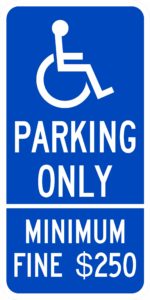Parking Lot Signage: Rules and Regulations
If you own a commercial property with a parking lot, you’ve already probably purchased signage. But whether you’re new to the game or a veteran, you might still be wondering, what exactly are the rules and regulations regarding my signage? How much signage do I need? What type of resources are available to me? Well, in this blog post we’re going to try and help you navigate the sometimes confusing waters of parking lot signage.
What Type of Signs am I Required to Have?
The two most important types of signage are handicap parking signs and fire lane signs. These types of signs are required by law and the amount and placement of these signs will differ depending on the size and location of your property.
Failure to properly follow your local laws regarding handicap parking and fire lanes can result in lawsuits. Fire lanes are determined by your local fire department and differ depending on your location.
For instance, in Jersey City, fire lanes are designated not by the property owner but by the Fire Official, with the approval of the Director of Public Safety and the Chief of Police. This might be slightly different in your neck of the woods, so be sure to search for your area’s specific requirements.
The American with Disabilities Act requires parking lots to provide handicap accessible parking along with clear and appropriate signage. Different states have different styles of signage. For instance,
“California handicapped parking space identification signs shall include the International Symbol of Accessibility. Signs identifying van parking spaces shall contain the designation ‘van accessible.’ Signs shall be 60 inches minimum above the finish floor or ground surface, measured to the bottom of the sign.” (Trafficsigns.com)
 A California Handicap Parking Sign
A California Handicap Parking Sign
While the basic information above also applies to New Jersey requirements, you can see that the sign you’re expected to provide looks quite different. The colors are different and there is no description of the penalty or fee for illegal parking.

A New Jersey Handicap Parking Sign
As we explored in our Parking Lot Liabilities blog, there are lots of specific rules concerning handicap spaces—the number of required parking spaces, the number of spaces large enough to accommodate vans, and much more. For a full rundown visit the United States Access Board.
But it’s not enough to know what you need to do; you have to have a way to do it. Dare can affix and repair your signage. We can do all your parking lot striping as well.
What Signs Am I Not Required to Have?
Surprisingly enough, you are not required to have stop signs in your parking lot though it could prove to be a liability. There may be exceptions to this rule but the only signs you truly must have are fire lane signs and handicap parking signs.
Signs such as Yield, Stop, Pedestrian Crossing, etc. are not required by law but may be encouraged, if not required, by your insurance company.
Even if you manage not to be held responsible for an accident occurring on your property due to a lack of signage, do you really want such a thing to happen on your property? Investing in proper signage today will save you headaches tomorrow. Plus, you’ll be creating a safer and more pleasant experience for your visitors and/or customers.
What Type of Signs Work Best?
According to a University of Michigan study, signs that depict movement work better than signs that simply contain words.
Fifty college students were fitted with an eye-tracker and told they would be evaluating landscape pictures on a screen as if they were driving on a road trip.
…The eye-tracking results showed that participants’ eyes focused on the sign sooner, and scanned areas around the sign more thoroughly, when the signs depicted movement.
In a second, larger study, researchers found that:
Again, participants had significantly faster reaction times in response to the high-motion warning signs. For a car going 60 mph, that 50 milliseconds of extra time translates into an additional 4.4 feet of distance—which can make the difference between a tragic accident and a close shave.
Granted, no one should ever be going 60 mph in your parking lot, but it’s a good fact to keep in mind. Signs such as the one below are better at quickly communicating information to a driver than signs with only words.

Need Signage?
Dare can help you with all your sign needs. Whether you need us to repair an old sign that has been damaged or knocked down, or if you’re starting from scratch, just call Dare!





